Yuvraj Singh – Brash yet India’s most loved cricketer
Yuvraj Singh belongs to the category of those few cricketers who defy the theory of ‘Attitude is more important than talent to succeed’.
He has immense talent in him, so much so that when he plays and he is in fine form, it seems as if he was born to play cricket and nothing else. Therefore, it comes as a shock to many when it became known that Yuvraj Singh was a roller-skating champion as a 12 year old school boy but his father threw away his roller skates in order to make him disciplined enough, to one day represent India on the cricket field. That was the turning point in his life and perhaps for Indian cricket, since from that day on Yuvraj’s journey of gradually falling in love with cricket had begun.
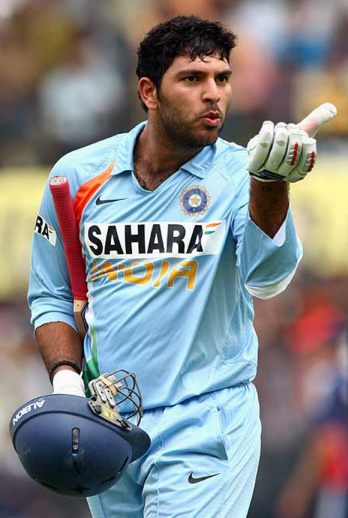
‘Yuvi’ as he is affectionately called, was born in the Punjabi capital of Chandigarh on December 12, 1981. His father, Yograj Singh, was a former cricketer who had played 1 Test match for India, and his first Test wicket was the man who would go on to coach India later and ironically allow the growth of Yuvraj as a cricketer, New Zealand’s John Wright.
While his mother Shabnam is the one responsible to have taken care of Yuvraj Singh till date, more than Yograj who wanted to pursue his other interests such as acting in films and live life the way he wanted to.
He first came into the limelight when he was the skipper of the Under-19 Punjab Team against Bihar in the Cooch-Bihar Trophy played in Jamshedpur in late 1999, where he hit 358. A few good performances won him a place in the Indian U-19 team for the World Cup in Sri Lanka in January 2000, which the team would go on to win, led by Mohammad Kaif, with whom he would go on to form one of the finest fielding partnerships in Indian cricket especially when Sourav Ganguly was captain of the team.
Yuvraj Singh rise got higher and higher as he was noticed by the Indian selectors, and came into reckoning of making his dream debut for India. He did so in the ICC Champions Trophy in Kenya in October 2000 against the home team, with India needing a dearth of young players for a complete makeover of the team, as per the plans of Ganguly, who was obviously uncompromising yet encouraging as the recently appointed Indian captain in all formats of the game.
Yuvraj Singh’s best moments on the Cricket
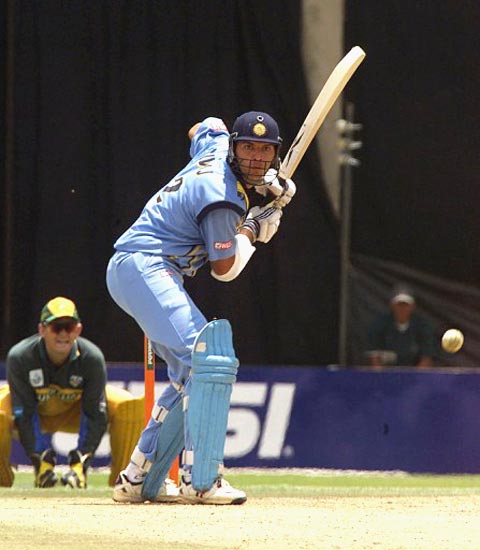
It was in his second one-day international that Yuvraj Singh became a household name in the country. The match was against Australia and it was the quarterfinal of the ICC Champions Trophy 2000. He came into bat when India were in a vulnerable position of 90/3 in 18.4 overs. What was to follow was a complete shredding of the mighty Australian bowling attack which comprised of Glenn McGrath, Brett Lee and Jason Gillespie.
Batting at No.5, he was dismissed eventually but not without a big score. His 84 came off just 80 balls, with 12 boundaries and a strike rate of 105. The world champions were upset in the end by 20 runs, as they failed to recover from the Yuvraj blitz in time. Not to mention, he was named the man of the match for that effort which took India into the semifinals of the tournament, going on to lose in the final to New Zealand. But a star was definitely born, as there was no looking back for Yuvraj Singh.
However, he was not able to fully cement a place in the Indian ODI team following a fluctuation in combinations being tried out for the World Cup 2003 in South Africa. This was only until the NatWest Series in England in the summer of 2002. His moment in the sun was his half century in the final against the hosts at the ‘Home of Cricket’, Lord’s.
India faced a daunting task of chasing 326 off 50 overs to win the tournament. They were on the verge of coming second best in another final, after being reduced to 146/5 in 24 overs. Yuvraj batting at No.6, alongside Mohammad Kaif put together a splendid 121 run partnership for the sixth wicket as India kept remaining in the hunt.
Considering the pressure on him, it was outstanding to see Yuvi score at a strike rate above 100 as his 69 came off 63 balls. By the time England finally got rid of him, they were in the backseat as India required 59 runs off 50 balls with four wickets in hand. India won by 2 wickets in what was one of the greatest one-day internationals of all-time and the highest run chase in ODI cricket for a period of time. Although Kaif won the man of the match award, Yuvi’s support act was instrumental in this victory and sealed him a place in the ODI team on a more consistent basis.
It is a dream of any aspiring cricketer to play Test cricket for his country some day, despite the advent of T20 cricket over the last nine years. Yuvraj’s ODI exploits made him eligible to be selected in the playing XI in the second Test against New Zealand in his hometown, Chandigarh in October 2003 following Sourav Ganguly not participating in the match due to an injury. He did not contribute significantly on his Test debut scoring just 25 runs in the game, but it would definitely go down for him as one of the finest moments of his playing career.
His rise was so high that although he has never been made the captain of the Indian team, he was made vice-captain at one stage and was seen leading the team on the field sometimes when Rahul Dravid, the captain or Virender Sehwag were off the field. Fortunately for India, Yuvraj is that type of a cricketer who prefers to focus on his individual game and does not possess the leadership qualities in him to captain the country or any team for that matter.
But come the 2007 T20 World Cup in South Africa and there was enough evidence of the fact that why Yuvraj Singh is one of the biggest match winners for India. The team was nascent, led by MS Dhoni for the first time. So Yuvi was one of the most experienced players in the team and he had to make his seven years of experience in international cricket, count in the shortest format of the game.
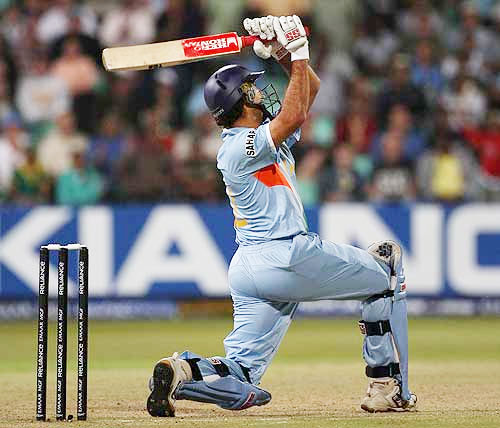
He achieved a feat which only a handful of cricketers might achieve in their lifetime. He hit 6 sixes in an over off England’s fast bowler Stuart Broad, in a crunch Super 8 game. The brutality of that innings was due to the fact that he was fired up, after a verbal duel with all-rounder Andrew Flintoff which showed that nobody should mess with Yuvraj otherwise they or their team faces dire consequences.
He created another record of scoring the fastest fifty in T20 internationals, off just 12 balls as he ended with 58 runs off 16 balls in India’s total of 218/4 in 20 overs, which gave India an 18 run win and a place in the semifinal against Australia. Yuvraj seems to enjoy playing the champions in a global event as he yet again proved to be a thorn in their path of victory. He was promoted to bat up the order at No.4 and hit 70 runs off only 30 balls, as India prevailed by 15 runs and achieved a place in the final against archrivals Pakistan. Those two fifties proved to be the ultimate difference in helping India emerge victorious in the inaugural edition of the World Twenty20, and a first global event win for the country since the 1983 World Cup in England.
Four years later, and it was the 50 over World Cup in the Indian subcontinent which marked Yuvraj’s maturity as a player. He had clearly grown into a versatile all-rounder, which India has always searching for in the one-day game but have not found much success in their pursuit. To win four man of the match awards, in a tournament like the World Cup is no meager accomplishment. It implies the tremendous form Yuvi was in, and the consistency at which he won India matches throughout the competition.
More importantly, the tournament was an example of Yuvraj’s dedication when it comes to playing for his country and knowing the event he was playing in. It has been revealed that Yuvraj played under some pain in his lung, which has now bubbled into cancer. For any sportsperson or athlete, it is not facile to play when you are suffocated from within due to a shortage of breath.
Yet, he picked up 15 wickets and smashed 362 runs in 9 matches of the tournament, which took India to a World Cup victory in the 50 over format after 28 years. India also became the first team to lift the trophy at home and achieving a rare double of winning a T20 as well as a 50 over World Cup. Therefore, it was a foregone conclusion to declare Yuvraj Singh as man of the tournament. The passion with which he approaches cricket could be seen with the tears in his eyes after the final as well as the pride in receiving that award, despite facing a slump since the last 18 months or so prior to the championship.
Yuvraj Singh in World Cup cricket
The Punjabi southpaw has participated in three 50 over World Cups till date as well as all the three 20 over World Cups to have taken place so far. Beginning with the 50 over version of the tournament, the first time he participated in it was in 2003 in South Africa, where India went with vigour under the leadership of Sourav Ganguly.
Yuvraj was then only two and a half years old in international cricket, so he made use of this tournament to ensure that the Indian selectors keep an eye on his performances so that he is retained in the side. He had a poor start, scoring just 45 runs in the first four matches India played in the tournament. However, he covered up soon in the match against England (yet again!) at Kingsmead, Durban. His 38-ball 42 proved to be vital in India’s score turning out to be exactly 250 in 50 overs. India went to on to beat England by 82 runs, which marked the beginning of India’s turnaround in the tournament from being mere pushovers to serious title contenders.
The next game was the marquee clash of all in the competition. India was to play Pakistan at Supersport Park, Centurion. The team was set a target of 274 to win the game courtesy a dogged batting performance by Pakistan. Sachin Tendulkar did give India a flying start with his 75-ball 98 but after he fell; the score was 177/4 in 27.4 overs, which meant that India still needed another 97 off 134 balls. Yuvraj Singh joined Rahul Dravid at the crease and together they added all those runs required to win, therefore negating the possibility of a repeat of Chennai 1999. Yuvraj hit 50 off just 53 balls, remaining not out as he played with a positive mindset, taking advantage of good batting conditions. India won by 6 wickets and were guaranteed a place in the Super Sixes stage.
The first of the Super Sixes matches was against minnows Kenya in Cape Town. Kenya batted first, only to finish with 225 runs on the board batting the entire 300 balls out. India were however left in a lurch, after being 108/4 in 29.3 overs when Yuvraj walked into bat. Alongside Ganguly, he added 118 for the fifth wicket and once again hit an unbeaten half century to avoid suffering an upset in the hands of Kenya. Ganguly may have scored a gritty hundred, but who knows what would have happened if Yuvraj did not end up with a 58 not out off just 64 balls?
However, after that there was nothing much from Yuvraj to see as he scored only 45 runs in the next three matches which included small contributions in the semifinal against Kenya and the final against the Aussies. He finished the tournament with 190 runs in 10 innings at an average of 27.14, which is average figures for a player to bat extremely lower down the order but decent due to some of his match winning knocks. He was handy with the ball as well, picking up 5 wickets in the 3 matches he bowled. While ofcourse his alongside Mohammad Kaif’s fielding was electrifying and pleasing to the Indian eye, as there could have been many runs saved by them which could have otherwise been detrimental to India.
Four years later, and Yuvraj was a much improved player when India headed to the shores of the Caribbean in the attempt to move one step further from 2003 and win the World Cup. Individually, Yuvraj had a decent tournament but India’s run lasted for only three matches, as they were knocked out in the first round itself, with the defeat against the low ranked Bangladesh at Port of Spain, Trinidad playing catalyst to it.
In the defeat, Yuvraj scored 47 off 58 balls, being the second highest scorer with Ganguly’s 66 taking precedence. But India were shot out for 191 in 49.3 overs and the match was as good as over at half team itself with the team’s confidence completely shattered. Bangladesh won by 6 wickets, which left India to win both their matches against Bermuda and Sri Lanka to qualify for the Super Eights and that too at an impressive net run rate.
The next match against Bermuda saw India scoring the highest ever total in World Cup history, scoring 413/5 in 50 overs as Yuvi contributed with 83 off just 46 balls, batting at No.5. India won comfortably by 257 runs, with a glimmer of hope that they could beat Sri Lanka as the batsmen seemed to have found some form. However, the team failed miserably against the Lankans too as they were comprehensively beaten by a margin of 69, not being able to chase a target of slightly above 250.
Yuvraj made one of the biggest mistakes of his life by running a non-existent single, with captain Rahul Dravid at their end as that partnership was crucial for India to hit back in the match. He was run out for 6, and with the score being 112/5 in 28 overs, the match was gone. India were bowled out for 185, and were sent packing by a team which deserved to win. Yuvraj Singh ended with 126 runs in 3 matches, at an average of 42 but he would definitely not remember this competition.
Yuvraj Singh’s Shines in the ICC Cricket World Cup 2011
But the 2011 World Cup was the example of the phrase ‘Cometh the hour, cometh the man’. The 30 year old saved the best for the last; the last in this case is the biggest tournament of them all in the cricketing calendar. He came into the tournament after suffering from a long period of slump, for 18 months or so due to poor form resulting from injuries which also saw him dropped from the ODI team for the first time in his career in the summer of 2010.
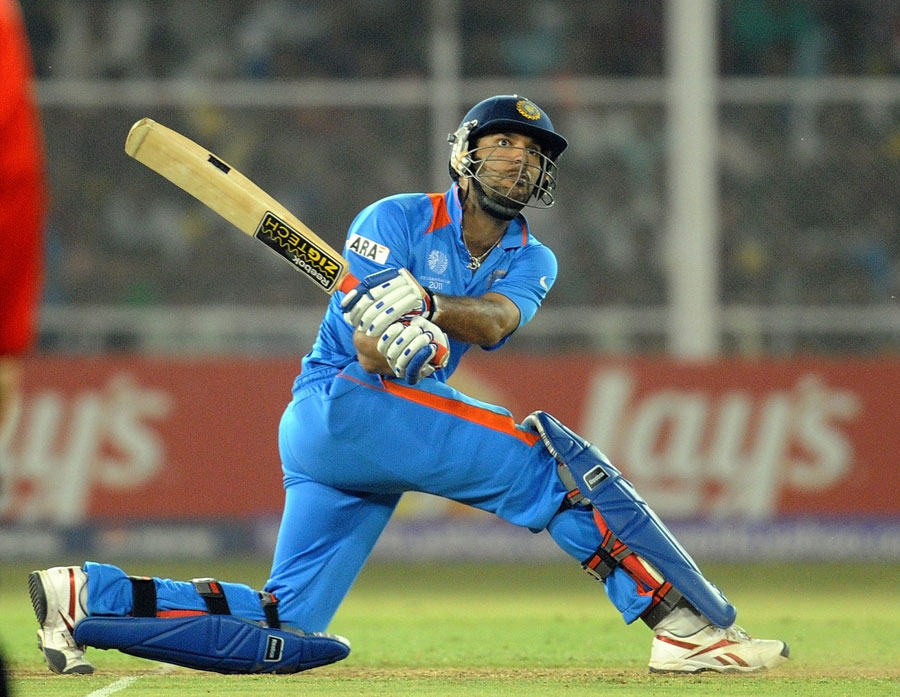
He either batted at No.4 or No.5 for the majority of the tournament, being one of the rare players who was one of the senior most batsmen of the side while also capable of bowling 10 overs of left-arm spin, an art which very few can master but Yuvraj learnt the tricks of the trade and improved on it. Besides, the skill which he is supposedly the best at returned in his arsenal, fielding. All the dives, the accurate throws and the acrobatic catches also made a grand comeback and it felt as if the young, enthusiastic Yuvraj had returned and not the pale shadow of the player a year ago who was struggling to get runs or even literally stand on the field for long.
In the first match against Bangladesh at Dhaka, he was not required to bat but the situation was different against England in the next game at Bangalore. This match marked the return of the Yuvraj the world actually knows, with his strokes on the off side being more confidence and the stride with the bat not being half-hearted, therefore going for shots time and again. He hit 58 off just 50 balls, at a strike rate of 116 as he was also involved in important fifty run partnerships with Sachin Tendulkar and MS Dhoni. India finished at 338 all out in 49.5 overs, but the match was a tie as England batted well on a flat wicket, which exposed the frailties of the Indian bowling attack.
However, Yuvraj hit two more back to back fifties to guide India to wins over pushover teams such as Ireland and Netherlands. Against Ireland in Bangalore, India had to chase 208 to win the match. India were 167/5 in 40 overs, as the game could have been anybody’s. But he alongside Yusuf Pathan finished the match off in style as the target was accomplished with 24 balls to spare. Yuvi hit a controlled but effective 50 not out off 75 balls. While against the Netherlands in Delhi, he came in to bat amidst another fluttering chase when the team was 99/4 in 14.3 overs, requiring 91 runs more to win. Yuvraj took his time and had an able partner in Dhoni to help India reach the target, winning by 5 wickets.
The only big failure for Yuvraj in the tournament was against South Africa where he failed to make an impact with the bat, scoring just 12 runs off 9 balls despite India being in a situation which was ideal for his style of batting, which is to attack and attack. While with the ball, he picked no wickets in his 8 overs which proved to be costly as South Africa won by 3 wickets.
Yet, he covered up for it in the match against West Indies in Chennai, which was the last group game before the knockout stages. Batting at No.4, he hit a scintillating 113 runs off 123 balls, as the innings took the game away from an already depleted West Indies side. His ten fours and two sixes played the anchor role in taking India to a total of 268 all out in 49.1 overs. The opposition was bowled out for 188, with Yuvraj bowling four overs and taking two wickets, of wicket-keeper batsman Devon Thomas and all-rounder Andre Russell which was a good wicket since he is no mut with the bat.
India’s quarterfinal was against Australia at Ahmedabad. Yuvraj decided to turn it on against the Aussies prior to the game itself, giving them the taste of their own medicine, as his brashness had returned. He took digs at the Australian’s poor form leading up to the game, targeting captain Ricky Ponting in particular. It may have proved to be effective as Australia won the toss and struggled to put up a sizeable total on the board. Plus, he bowled his heart out, picking up 2 wickets for 44 runs in his 10 overs, which included the big scalps of the well-settled wicketkeeper batsman Brad Haddin and Michael Clarke, who is one of the best players of spin in the Australian side.
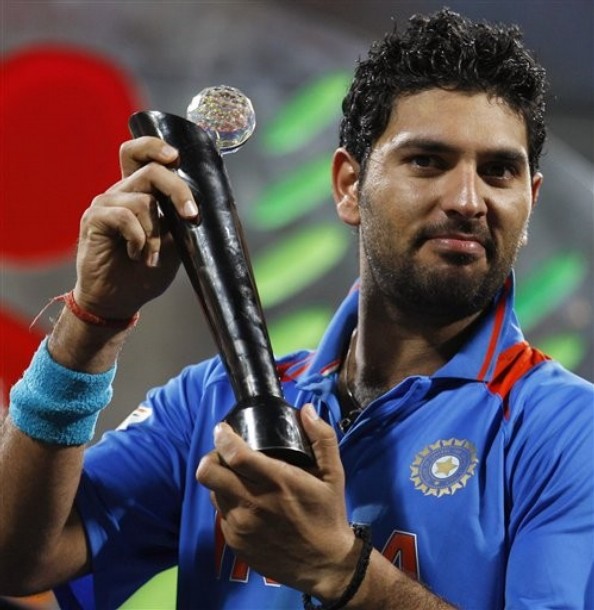
That left India 261 runs to win the game in 50 overs, and Yuvraj joined Gautam Gambhir at the crease with the score being 143/3 in 28.3 overs. Two more wickets fell, which made Indian fans and the dressing room nervous for sure. Yet, Suresh Raina and he put together a stunning 74 run partnership for the sixth wicket as he sealed the game for India with three boundaries in an over off Brett Lee being the highlight of his innings.
It was fitting that he hit the winning runs as once again Yuvi had helped India knock out the world champions from an ICC event. The match meant India was back in business and as prime contenders to win the title. He played so well that this was his fourth man of the match award in the competition, easily an all time World Cup record.
The semifinal against Pakistan was in his hometown in Mohali. He was dismissed on the very first ball that he played, but picked up the wickets of the No.3 Asad Shafiq and more importantly, the No.4 Younis Khan in his 10 overs, giving away 57 runs. India won the game by 29 runs to set up a grand finale with Sri Lanka in Mumbai.
April 2, 2011 would always be etched in the minds of every Indian fan, but more in Yuvraj’s mind as he was rewarded with the man of the tournament for having scored 362 runs in aggregate, averaging a mesmerizing 90.5 and picking up as many as 15 wickets in the competition which included a five wicket haul against Ireland. Against Sri Lanka, Yuvi picked two more wickets but for just 49 runs in 10 overs, and was at the crease when Dhoni hit a towering six over the long run off Nuwan Kulasekara to ensure that India won the championship as he remained not out on 21 off 24 balls.
His overall record in 50 over World Cups is 678 runs in 21 innings, averaging 32.29 and 20 wickets in 11 matches.
Yuvraj Singh in the T20 World Cup
When it comes to T20 World Cups, Yuvraj had one of the most memorable tournaments of his life in the 2007 edition in South Africa where he ended with 148 runs in 5 innings at an average of 29.60 but more importantly, a strike rate of 194.74! This also established him as one of the most sought-after T-20 players in world cricket, with his six of 119 m off the bowling of Brett Lee being the longest of the tournament.
In the 2009 World T20 in England, he had a better showing than the last time but unfortunately it did not help India qualify for the semifinals, having been knocked out in the Super Eights round itself, therefore not defending the title successfully. Yuvi was the highest run getter for India in the competition with 156 runs in 5 games at an average of 39 at a strike rate of 115.56, which is magnificent for T20 cricket. His top score of 67 off only 55 balls came against the West Indies at Lord’s.
While in 2010 in the West Indies, he had a mediocre tournament with the bat as he scored 74 runs in 5 matches at a poor average of 18.5. The team was in such pathetic form that they deserved to be once again thrown out of the competition in the Super Eights stage, as the IPL seemed to have made them completely exhausted and as a result disinterested in playing cricket.
His overall record in T20 World Cups is 378 runs in 15 matches at an average of 25.20, at a strike rate of 133.15.
Yuvraj Singh’s ODI records
He has been one of India’s most prolific run getters in this format of the game. Having played 274 matches, he has loads to experience which is crucial to India’s success in one-day cricket atleast till the 2015 World Cup in Australia. He has as many as 8051 runs to his name at an average of 37.62, remaining not out 38 times. Yuvraj maintains an amazing strike rate of 87.58, and has scored a lowly 13 hundreds but 49 half centuries.
While bowling-wise, he has picked 109 wickets with his best bowling figures being 5/31 against Ireland in a World Cup 2011 match in Bangalore and possessing an impressive economy rate of 5.04. In terms of fielding, he has taken 84 catches in ODIs, making him one of the topmost fielders India has ever possessed in this format of the game. Although the level of fielding has reduced in the last 18 months due to injuries, if anyone in the Indian team can be considered close to resembling someone like Jonty Rhodes, it has to be Yuvraj Singh. He must have saved the maximum amount of runs for India on the field and is accountable for the fielding standards of the team to have improved in the last decade, which can give them a competitive advantage from the rest of the teams.
In the first six years of his career, he batted at either No.6 or No.7 spot which explains why he has scored fewer centuries and hence his career average is comprehensive. His first ODI hundred came in a match against Bangladesh in Dhaka, right after the World Cup 2003. He remained not out at 102 off just 85 balls with as many as 9 fours and 4 sixes, which took India to a total of 276 in 50 overs. India won that match by 200 runs.
However, it is his second hundred which is his highest ODI score till date. It came against Australia at the Sydney Cricket Ground in January 2004. India were struggling at 80/3 in 15.2 overs when Yuvraj came out to bat, joining his perfect foil VVS Laxman. Both of them ended with hundreds but the Yuvi one was more entertaining, scored at a much brisker pace. By the time he was out with four balls to spare in the innings, he had done the damage by smashing 139 runs off only 122 balls, involving 16 fours and 2 sixes. However, rain played spoilsport as Australia won the match by 2 wickets courtesy the D/L method.
The two years, 2005 and 2006 were the best years of his career in which he flourished under the captaincy of Rahul Dravid and the coaching of Greg Chappell. He scored 1560 runs in 40 ODIs, at an average of 39 and involved four more hundreds in his tally. It was Yuvraj who played a big hand in India’s 16 consecutive chases in ODI cricket being successful ones from a period of October 2005 – May 2006. He formed solid partnerships with captain Dravid and the then emerging wicketkeeper batsman MS Dhoni to play the role of the go-getter who finished off matches for the team on his own will, leaving others to adapt as per the situation.
Three more hundreds were to follow at home; one was against Australia in Hyderabad in 2007 which was his second ton at the venue. This was an innings of controlled aggression as Yuvraj this time had to play according to the situation, since he was running out of partners at the other end. His 122 off 115 balls was the story of a one-man army performance of India, as they lost by 47 runs chasing 290 to win.
While a year later, he hit back to back hundreds against England. In the first ODI of the 5-match series at Rajkot, he made excellent use of the batting conditions as he walloped the mediocre English bowling attack for 138 runs off a mere 78 balls, at a colossal strike rate of 176.92 and hitting 16 fours and 6 sixes, therefore carrying from where he left off in the World T-20 2007 match against the same opposition.
The second game was at Indore and his magnificent run of form continued. This innings was played at a much slower pace following the failure of the top order, as the team was reduced to 29/3 in 7.3 overs. With the help of Gautam Gambhir and Yusuf Pathan, Yuvraj stayed at the crease till the last over, facing 122 balls and scoring 118 runs. It took India to a total of 292 in 50 overs, and it proved to be enough as England were bundled out for 238. Yuvi starred with the ball as well, picking 4 wickets for 28 runs in 10 overs which included wickets of the top order batsmen such as Matt Prior, Owais Shah, Andrew Flintoff and captain Kevin Pietersen. In the process, he won his second man of the match award in consecutive matches.
He scored another hundred in Sri Lanka in January 2009, while his last century came in the World Cup 2011 against West Indies in Chennai.
Yuvraj Singh’s Test cricket records
Despite having played over a decade of international cricket, Yuvraj has never been able to cement a spot in the Test team and when he has been able to achieve it, it is on a recurring basis.
This is probably due to the fact that India’s batting line-up has been so powerful and in top form over the years that the likes of Rahul Dravid, Sachin Tendulkar, VVS Laxman and Sourav Ganguly have not given him an opportunity to play. As well as the fact that his style of batting is not suited for Test cricket since he does not possess the temperament to bat for long hours and play especially in swinging conditions.
Yuvraj has mentioned how desperate he is to play Test cricket on a regular basis for India, however his statistics will not win him a place in the team on merit.
He had an impressive tour of Pakistan in March 2004 where he played all the three Tests. He scored 220 runs in four innings, which included a gritty 112 on a green top in Lahore in the first innings when the rest of the batsmen struggled. And that too of a mere 129 balls, hitting 15 fours and 2 sixes having batted at No.6. India finished with 287, and were thrashed by 9 wickets.
His second Test hundred incidentally, also occurred in Pakistan conditions. It was two years later on a minefield of a wicket in Karachi in the final Test of the 2006 series. He slashed 122 off just 144 balls, with 19 fours and 1 six. Once again, there was no one to support him at the other end, as India lost embarrassingly by 341 runs and consequently the series 0-1.
His third and final Test century was yet again made against Pakistan but this was in India in the 2007 series. He replaced an injured Sachin Tendulkar for the final Test at Bangalore and made full use of this opportunity he got by scoring his highest score of 169, after India were reeling at 61/4 at one stage. This time though, Sourav Ganguly was involved in a 300 run partnership with him for the fifth wicket before Yuvi fell, facing 203 balls in his innings. India reached 626 all out but had to settle for a draw, having missed out by just three wickets as Yuvraj made the match interesting with his two wickets in the second innings.
His finest moment however in this format of the game was the unbeaten 85 he hit against his favourite opponents England at Chennai in the first Test of the 2008 series, right after the terror attacks in Mumbai. The innings is special because India was set a massive target of 387 to win by England and Sachin Tendulkar needed someone along with him at the crease to help India reach home. They did so eventually by 6 wickets with Yuvraj batting with great application, as he faced 131 balls in the innings, not worried about the pace at which he was scoring.
He has only played 37 Tests and scored 1775 runs at an average of 34.80 which is not bad for a batsman to have not played consistently in this format, and when he gets his number, he is made to bat at No.6. Sometimes he was tried as an opener, which proved to be unsuccessful since the Indian team management failed to realize that Yuvraj does not have the game to be an opener in Test cricket and he was not needed at the top with Sehwag already there to thrash a bowling attack.
Yuvraj Singh in the Indian Premier League (IPL)
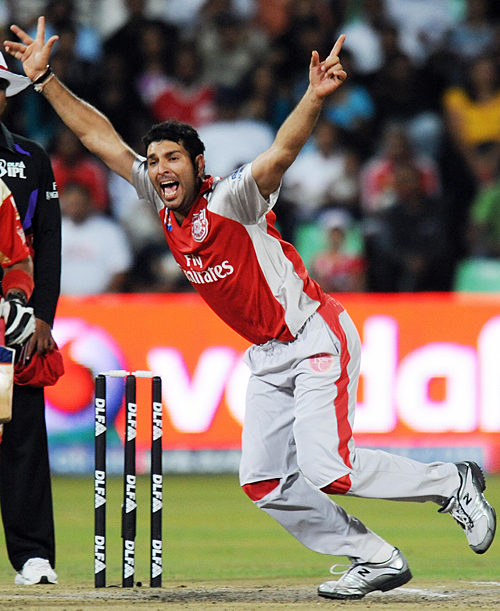
No Indian cricketer’s story is complete these days without mentioning his IPL stints. His 6 sixes in the 2007 World T20 had made him the hottest property in the format of the game and so he was named captain and the icon player of the Preity Zinta-owned Kings XI Punjab team in the 2008 and 2009 season.
He led the team to the semifinals in 2008 with his batting and fielding stunning to watch. The next season, which was in South Africa, saw Punjab finishing fifth in the tournament, narrowly missing out reaching the last four for the second time. But he picked up his first hat-trick in T20 cricket against the Royal Challengers Bangalore in Durban, when he dismissed Robin Uthappa, Mark Boucher and Jacques Kallis in back-to-back deliveries. While another hat-trick was in store of him in the round robin game against the eventual champions, Deccan Chargers where he picked Herschelle Gibbs, Andrew Symonds and Venugopala Rao in consecutive deliveries.
Hence, credit has to be given to the IPL to make Yuvraj a better bowler especially in the shorter formats of the game, making him a batting all-rounder India need for the future if they have to prove that they deserve to be world champions.
In 2011, he was not retained by Kings XI Punjab following a poor season the previous year despite not being captain. He was instead picked by the new franchise, Pune Warriors India owned by the Sahara group of companies, which is in the news off late for backing out of the sponsorship of the Indian cricket team and perhaps the ownership of the Pune team.
Yet, Yuvraj was bought for $1.8 million and named captain of the team. Although it finished ninth out of the ten teams in the last year’s IPL, Yuvi did well by scoring 343 runs in 10 innings, with two fifties to his name.
Yuvraj Singh and controversies
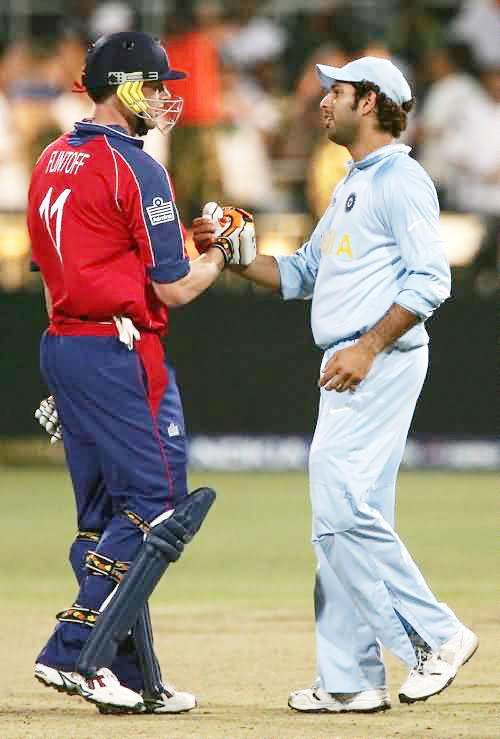
The exuberant character that is, Yuvraj is no stranger to controversies, whether it is on the field or off the field. He is known for his rivalry against England in particular, just as Harbhajan Singh is against Australia. Since he has had verbal duels with Andrew Flintoff and Kevin Pietersen, after he called him a ‘pie-chucker’ for his bowling action in November 2008. Famously, in the World T20 semifinal against Australia in 2007, he famously started abusing as a part of a wild celebration after taking a catch in the deep.
However, he has rarely got into trouble with the ICC in terms of his on-field behavior and has made India proud of the way he plays. His performances have never been under scrutiny and as a result, he has maintained a squeaky clean image when it comes to playing for India atleast.
Off the field though, his personal life seems to be extremely active. He has been a huge party-goer and seems to enjoy life to the fullest in discotheques or bars where he gets the opportunity to dance or drink with his group of friends. Or for that instance, he also has had a long list of girlfriends, perhaps the longest amongst any current player in the Indian team as he favours the spicy Bollywood actresses such as Kim Sharma, Deepika Padukone, Riya Sen and Minisha Lamba to name a few. He was also linked with his team owner and another actress, Preity Zinta for a period of time.
Perhaps, Yuvraj could have been a much fitter and hence a greater modern day player if he would keep his partying antics in control. Yet, he has to be admired for battling with his problems in his personal life well enough to have a decent professional life, as it is for certain that his performances on the field are not affected by all this.
Yuvraj Singh’s present and the future

Currently, as it is now known across the cricketing globe and not just India, Yuvraj is suffering from cancer in his left lung which is fortunately in the first stage, making it curable as per the doctors whom he has consulted. He is in the USA undergoing chemotherapy. It is unsure whether will the cancer have a long-term impact on his life span since people with lung cancer tend to survive for a maximum of five years.
However, there is no such fear so far which means that he can come back into playing international cricket in the future. But it is always a mountainous task for any sportsperson to return from cancer and play competitively and professionally in a sport. Yuvraj’s biggest source of inspiration has to be the cycling legend from the USA, Lance Armstrong who fought cancer from the age of 25, mainly with a positive attitude in his mind that he will do more than just to survive and defy medical reports. He did that successfully and as they say, the rest is history. He went on to win seven Tour de France titles, one of the most prestigious in the sport.
Or even in cricket, a South African cricketer called Dave Callaghan had also suffered from the same disease in 1991. But miraculously, he was treated in record time and got a call up to play for his country against New Zealand in a home series and won the man of the match award in the first ODI after his return, smashing 169 and picking 3/32.
Yuvraj says he is a fighter, and we have seen his capabilities in the World Cup last year that he can play even in the worst of pain. If he recovers successfully, there is nothing like it for India who need him back in the ODI team since they still lack a potent all-rounder, although Ravindra Jadeja who could be called his replacement, is making rapid strides. While in Tests, this period of time will be his best opportunity to win the No.6 spot or any other in the batting line up as such, since the seniors are under pressure to call it a day anytime soon.
He is one of the most underestimated players in Indian cricket but effective for sure.

Leave a Reply